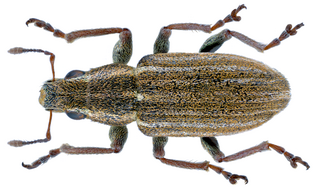
The Curculionidae are a family of weevils, commonly called snout beetles or true weevils. They are one of the largest animal families with 6,800 genera and 83,000 species described worldwide. They are the sister group to the family Brentidae.

Hylobius abietis or the large pine weevil is a beetle belonging to family Curculionidae. This species is widely regarded as the most important pest of most commercially important coniferous trees in European plantations. Seedlings planted or arising from natural regeneration after clear felling operations are especially at risk. The adult weevils cause damage by eating the bark of seedlings around the 'collar' of the stem, thus 'ring-barking' the tree seedling which usually results in its demise.

Curculio nucum, the nut weevil, is a medium-sized beetle, with an especially elongated snout, characteristic of the Curculionini tribe of the weevil family (Curculionidae). Its larvae develop in hazel nuts Corylus avellana, being a serious pest in hazelnut orchards. It occurs in most of Europe, from south Sweden, Finland and Great Britain to the Mediterranean.

Anthonomus eugenii is known as the pepper weevil. This beetle feeds and lays eggs on plants in the genus Capsicum and a few species in the genus Solanum. A. eugenii is native to Mexico, however, it is an important pest of Capsicum in Florida, Puerto Rico, and Central America.

Naupactus is a genus of beetles in the weevil family Curculionidae, the true weevils. They are known commonly as whitefringed beetles. Many species of the genus are considered pests, both as larvae and as adults. The genus is native to the Americas, where it is distributed from Mexico to Argentina; the highest species diversity is in Brazil. Several species have been introduced to the United States and New Zealand.

Hylobius transversovittatus is a species of weevil in the family Curculionidae. It is native to the Old World where both adults and larvae feed on purple loosestrife. This plant is regarded as an invasive species in North America and the weevil has been introduced into both the United States and Canada in an effort to control the plant.

Anagotus fairburni or flax weevil is a large flightless weevil. It feeds on leaves of New Zealand flax species where it produces a characteristic feeding notch. It is found on islands and in alpine areas of New Zealand.

Curculio elephas is a species of beetle in the family Curculionidae, the true weevils. It is known commonly as the chestnut weevil. It is a serious pest of chestnut in Europe.

Acanthoscelides obtectus, the bean weevil, is a species of bruchid beetle. The species was described in 1831 by Thomas Say.

Pyronota festiva, commonly known as mānuka beetle or mānuka chafer, is a member of the genus Pyronota of the beetle family Scarabaeidae. It is a scarab beetle endemic to New Zealand, and is commonly found in mānuka trees, hence the beetle's name. In some areas it is considered a pasture pest.

Listronotus bonariensis is a species of weevil that is native to South America and is commonly known as the Argentine stem weevil. It is a pest of grasses and cereals, with the larvae being more destructive than the adult insects. It has spread to Australia and New Zealand, where it is regarded as a pest species.

Hypera postica, commonly known as the alfalfa weevil, is a species of beetle in the superfamily Curculionoidea; it can be found in alfalfa fields throughout Europe. Considered a destructive threat to alfalfa production in North America, several accidental introductions have been successfully countered though the use of a variety of biological control species.

Sitona lineatus, commonly known as the pea leaf weevil is a species of weevil with a Palearctic distribution. It is a common pest of beans, peas, and other plants in the family Fabaceae. Adult beetles of S. lineatus measure 3.4-5.3 mm in length. They are characterized by a series of colored scales arranged in alternating lines (striae) on the elytra; it is from this characteristic where the species gets its name lineatus meaning 'lined' or 'striped'. The head and pronotum also have fine pointed setae amongst the scales. The antennae are clubbed, pointed and preceded by 7 segments. The femora is dark, but tibiae and tarsi are red. As a member of Order Coleoptera (beetles) their forewings are modified to form hardened covers over the thorax and abdomen, with the hindwings for flight underneath.

Ceutorhynchus obstrictus, the cabbage seedpod weevil, is a species of snout beetles or true weevils which is widespread in Europe and lives on several types of crucifers. The adult weevils feed on the leaves, but breed in the seedpods, where the larvae destroy the seeds. It can be a harmful pest on crops like rapeseed/canola, cabbage and relatives or Brassica rapa.

Metamasius callizona, or the Mexican bromeliad weevil, is an invasive species in Florida, US that targets several species of bromeliad. This species is native to southern Mexico, Guatemala, and Panama, and was first documented in Florida in 1989.

Curculio sayi, the small or lesser chestnut weevil, is a species of true weevil in the family of beetles known as Curculionidae.
Listronotus oregonensis, the carrot weevil, is a species of weevil in the beetle family Curculionidae. It is found in North America.

Cosmopolites sordidus, commonly known as the banana root borer, banana borer, or banana weevil, is a species of weevil in the family Curculionidae. It is a pest of banana cultivation and has a cosmopolitan distribution, being found in all parts of the world in which bananas are grown. It is considered the most serious insect pest of bananas.

Odoiporus longicollis, commonly known as banana stem weevil or banana pseudostem borer, is a species of weevil found in South Asia and South East Asia.
Euwallacea perbrevis, commonly known as tea shot-hole borer, is a species of weevil native to South and South-East Asia through to Australia, but introduced to Western countries.



















